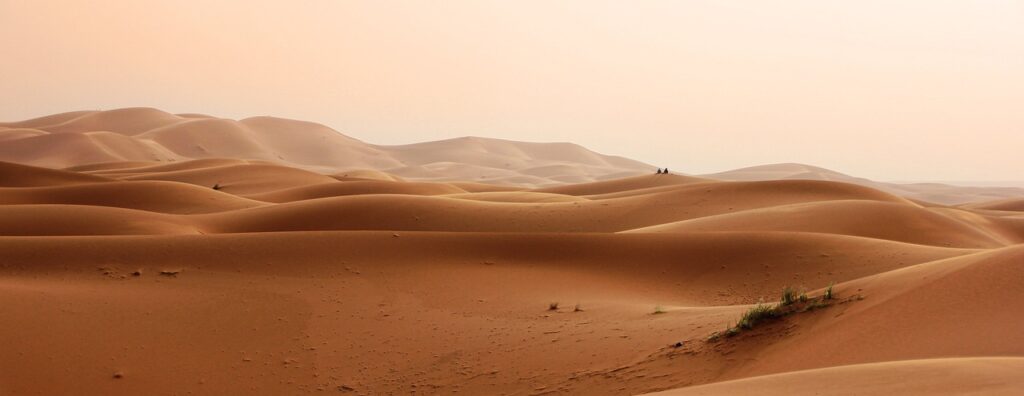Pakistan is a country with diverse geography and climate, and one of its most captivating features is its deserts. These vast, arid landscapes are home to a rich array of flora and fauna, as well as cultural and historical treasures waiting to be discovered.
Today, we’ll explore the beauty and diversity of Pakistan’s deserts, highlighting their natural wonders, cultural significance, and the adventures that await those who venture out to explore them.
The Diversity of Deserts in Pakistan
There are several deserts in Pakistan, with the most well-known being the Thar Desert, the Cholistan Desert, and the Kharan Desert. However, some sources may consider smaller arid regions such as the Thal Desert and the Nara Desert as distinct deserts as well. Overall, the exact number of deserts in Pakistan may vary depending on the criteria used to define a desert.
Considering the most known deserts, here is a little information about the three largest deserts in Pakistan
- The Thar Desert, located in the southeastern part of the country, is the largest and most famous desert, covering an area of 175,000 square kilometers.
- The Cholistan Desert, also known as the Rohi Desert, is located in the southern part of Punjab province, covering an area of over 16,000 square kilometers.
- The Kharan Desert is located in the southwest province of Balochistan, covering an area of 50,000 square kilometers.
Despite their similarities, each of these deserts has unique features and characteristics that set them apart. The Thar Desert, for example, is known for its shifting dunes and its vibrant culture. The Cholistan Desert is known for its ancient forts and palaces. The Kharan Desert is known for its stark beauty and rugged terrain.
Read more: Discovering the Beauty of Northern Areas of Pakistan
The Natural Wonders of Pakistan’s Deserts
Pakistan’s deserts are home to a variety of natural wonders, including unique geological formations, stunning rock formations, and diverse wildlife. The deserts are characterized by their harsh, arid landscapes. Still, they are also home to a variety of plant and animal life that has adapted to survive in this extreme environment.
The flora of Pakistan’s deserts includes a variety of species, including acacia, date palms, and tamarisk. These plants have evolved to survive in harsh desert conditions and are an important food source for many of the desert’s animals.
The fauna of Pakistan’s deserts includes a variety of species, including gazelles, ibex, and jackals. These animals adapt to the harsh desert environment and can survive very little water.
The Cultural Significance
Pakistan’s deserts have played an important role in the country’s history and culture and continue to be an important part of its cultural heritage. The people who live in the desert regions have a unique culture and way of life and have adapted to the harsh desert environment for centuries.
The desert regions of Pakistan are home to a variety of ethnic and linguistic groups, including Sindhis, Balochis, and Punjabis. Each of these groups has its unique culture and traditions, and they have all contributed to the rich cultural heritage of the desert regions.
One of the most significant cultural features of the desert regions is the camel, which has played an essential role in the lives of the desert people for centuries. Camels are used for transportation, milk, and meat, which are an important part of the local culture and way of life.
The Adventure of Exploring Deserts in Pakistan
Exploring Pakistan’s deserts is an adventure like no other. From the shifting dunes of the Thar Desert to the ancient forts and palaces of the Cholistan Desert, there is no shortage of things to see and do in these vast and rugged landscapes.
Some of the most popular activities in the desert regions include trekking, camel safaris, and camping. These activities allow visitors to experience the desert’s beauty and solitude while immersing themselves in the local culture and way of life.
Read more: 7 Best Places to Visit When in Nathia Gali in 2023
Preserving Pakistan’s Deserts
Despite the many wonders of Pakistan’s deserts, these fragile ecosystems are threatened by various human activities. Overgrazing, deforestation, and urbanization are just a few factors contributing to the degradation of these unique landscapes.
It is crucial to take steps to preserve these deserts and protect them for future generations. This can be achieved through sustainable tourism practices, conservation efforts, and implementing policies that prioritize the protection of these vital ecosystems.
Conclusion
Pakistan’s deserts are an awe-inspiring natural wonder and are home to a diverse array of flora, fauna, and cultural treasures. Exploring these deserts is a unique adventure that allows visitors to experience these rugged landscapes’ beauty and solitude while immersing themselves in the local culture and way of life.
It is crucial that we take steps to protect these deserts and preserve them for future generations to enjoy. By promoting sustainable tourism practices and implementing conservation efforts, we can ensure that these precious ecosystems remain intact for years to come.
